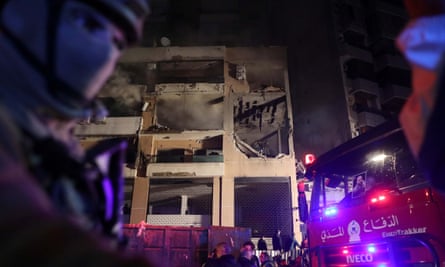The death toll from Israeli attacks on Gaza has climbed to more than 22,000 after a day of intense fighting across the territory, including in the southern city of Khan Younis, where the Palestinian Red Crescent (PRCS) said five people had been killed in a second Israeli attack on its compound.
The day after Israel announced the first drawdown of troops from Gaza, there was no sign of relief for its residents, who after three months of heavy bombardment and weeks of ground fighting, are almost all displaced, hungry and stalked by disease.
In Beirut, an Israeli drone strike killed the senior Hamas official Saleh al-Arouri late on Tuesday afternoon, marking a significant escalation of the war against Hamas as well as its conflict with Hezbollah.
Nearly three months into the war, no top Hamas figures have been killed or captured in Gaza. On a visit to soldiers stationed there, the Israeli defence minister, Yoav Gallant, said the government was planning for a long war.

“The feeling that we will stop soon is incorrect. Without a clear victory, we will not be able to live in the Middle East,” he said.
Five Israeli brigades, comprised of several thousands troops, will leave Gaza in the next few weeks. Some for more training or rest, some to return to civilian life and work, which the government hopes will ease pressure on the economy, as it prepares for months of war in Gaza and possibly beyond.
In a rare engagement with the international court of justice, Israel said it would defend itself against a case launched by South Africa at the weekend, which accuses the state of committing genocide in its military campaign in Gaza and asks judges to order an immediate halt to attacks.
Israel, which says the top UN court is biased against it, has denounced the case as a “blood libel”. But the charges are just one part of intensifying international pressure over the ferocity of Israeli attacks on Gaza.
The United States, Israeli’s most important ally, has staunchly rejected calls for a ceasefire, saying the country has the right to defend itself after the 7 October attacks by Hamas that killed 1,200 people, mostly civilians.
But even US officials have become increasingly critical of the toll of the military operation launched in response.
Israeli bombs and the ground assault have now killed at least 22,185 Palestinians, health authorities in Hamas-run Gaza said on Tuesday, with thousands more bodies buried under rubble. The majority of the dead are women and children.
Among the latest victims were people who had fled their homes to camp in and around the PRCS headquarters in Khan Younis.
The attack “result[ed] in several fatalities and wounded among the 14,000 displaced individuals housed in the PRCS’s premises and the adjacent Al-Amal Hospital,” the organisation said in a statement on X. They had “sought refuge in the PRCS’s premises and the nearby Al-Amal Hospital, considering it a safe haven.”
Israel’s military claims senior leaders are hiding in tunnels under Khan Younis. Fighting there was currently “focused on what is above the tunnels where senior Hamas officials are hiding, at great depths,” Gallant said.

The military has repeatedly said it was nearing operational control of northern parts of the strip. Twelve battalions – about half of Hamas’s estimated fighting force at the start of the war – had been broken apart there, Gallant said.
In a sign of Israeli confidence that Hamas’s capacity to launch rockets from the strip has been severely degraded, residents from seven communities near Gaza who were evacuated after the 7 October attacks have been told they can return home soon.
Gallant added however that thousands of Hamas fighters were still fighting in the north, “several thousand out of the 15 or 18,000 that were in this area.” Not all members of the destroyed units – which each had more than 1,000 men – had been killed, but they were no longer operational, he said.
“This does not mean that we have eliminated all the terrorists – but the scenario in which a terrorist may pick up binoculars, report back, shoot mortars, and then a battalion commander sends over manoeuvring forces – this scenario is irrelevant here,” Gallant said.
